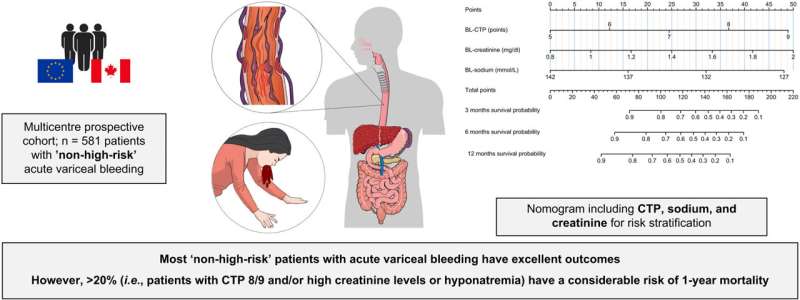This article has been reviewed according to Science X's editorial process and policies. Editors have highlighted the following attributes while ensuring the content's credibility:
fact-checked
trusted source
proofread
Risk assessment after severe complication of liver cirrhosis improved

Approximately half of patients with advanced liver disease have varicose veins in the esophagus and stomach, and more than a fifth of them experience bleeding from these varices into the digestive tract.
This is a life-threatening complication that contributes significantly to the still high mortality rate of cirrhosis. An international research team led by Lorenz Balcar and Mattias Mandorfer from MedUni Vienna improved the system for stratifying the mortality risk of variceal bleeding.
They were able to identify a previously undefined group of patients for whom the use of liver stents to relieve portal vein hypertension could be indicated. The research was recently published in the Journal of Hepatology.
Varicose veins in the esophagus and stomach are caused by increased pressure in the portal vein, mainly due to cirrhosis. As a result of liver scarring, the flow of portal venous blood through the liver vein is impeded, so that bypass circuits such as varicose veins (varices) form.
Internal bleeding from these varices into the digestive tract is life-threatening, but in the vast majority of cases can be stopped, at least initially, by medication and endoscopic measures. Patients classified as high-risk should also receive a liver stent to relieve the portal vein hypertension and prevent the recurrence of variceal bleeding or reduce mortality.
In the current study, the scientific team led by Lorenz Balcar and Mattias Mandorfer (Vienna Hepatic Hemodynamic Lab, Division of Gastroenterology and Hepatology, Department of Medicine III) showed that a subgroup of supposedly low-risk patients also has a considerable mortality risk and could benefit from the implantation of a liver stent.
Targeted use of liver stents
To reach this conclusion, the research group analyzed data from the International Variceal Bleeding Observational Study Group of the Baveno Cooperation, a consortium of the European Association for the Study of the Liver (EASL), which defines the international standard for the management of portal hypertension.
A new risk assessment system has been developed for patients currently classified as low-risk patients. After a variceal bleeding, these patients are currently treated primarily with medication, so-called non-selective beta-blockers, and endoscopically with ligation.
While conventional therapy offers the majority of patients good chances of survival, the newly identified group has a significantly higher mortality rate within the first year after variceal bleeding.
"Whether the implantation of a liver stent is also indicated in these patients will now be clarified by a randomized study," say first authors Lorenz Balcar and Mattias Mandorfer about the next steps. In any case, the current findings can be seen as a cornerstone for the targeted use of liver stents and the further personalization of treatment for variceal bleeding.
More information: Lorenz Balcar et al, Predicting survival in patients with 'non-high-risk' acute variceal bleeding receiving β-blockers+ligation to prevent re-bleeding, Journal of Hepatology (2023). DOI: 10.1016/j.jhep.2023.10.007





















